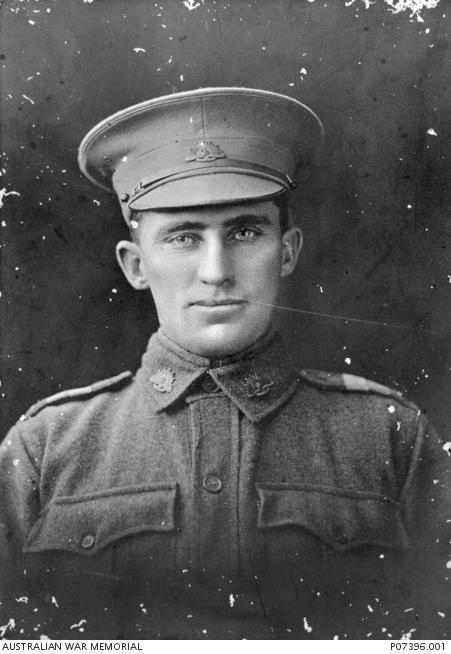Pte
James Martin Clement Neagle
Information about birth
|
Year of birth: 1889 |
|
Place of birth: Port Pirie, South Australia, Australia |
General information
|
Last known residence: Hummock Hill, South Australia, Australia |
|
Profession: Ironworker |
|
Religion: Roman Catholic |
Army information
|
Country: Australia |
|
Force: Australian Imperial Force |
|
Rank: Private |
|
Service number: 2233A |
|
Enlistment date: 11/05/1916 |
|
Enlistment place: Adelaide, South Australia, Australia |
|
Units: — Australian Infantry, 50th Bn. (Last known unit) |
Information about death
|
Date of death: 18/10/1917 |
|
Place of death: Celtic Wood, Zonnebeke, Belgium |
|
Cause of death: Killed in action (K.I.A.) |
|
Age: 28 |
Cemetery
|
Buttes New British Cemetery, Polygon Wood Plot: XXVIII Row: A Grave: 2 |
Distinctions and medals 2
|
British War Medal Medal |
|
Victory Medal Medal |
Points of interest 4
| #1 | Place of birth | ||
| #2 | Last known residence | ||
| #3 | Enlistment place | ||
| #4 | Place of death (approximate) |
My story
James Martin Clement Neagle was a 28-year old ironworker from Port Pirie, South Australia. He volunteered in May 1916 and served with the Australian Infantry 50th Battalion in Flanders. He was wounded during the aftermath of the Battle of Messines and was heavily traumatized, suffering from shellshock for months. He was only able to rejoin his unit on 7 October 1917.
After having seen action during the Battle of Polygon Wood (26 September – 3 October 1917), the 4th Australian Division took part in the First Battle of Passchendaele (12 October 1917). Both of these attacks were stages of the Third Battle of Ypres. The latter was carried out by the 12th Brigade of the 4th Australian Division. The Brigade wasn’t able to capture its objective at the Keiberg Spur and was forced to withdraw. Overall the First Battle of Passchendaele had been an utter failure. Casualties had been high along the whole line, while no significant gains had been made.
On the following day the 50th Australian Battalion relieved the 49th Australian Battalion in the frontline near the hamlet of Nieuwemolen and Defy Crossing. German shelling of the Battalion’s positions was persistent throughout the following days. Meanwhile the 50th Battalion started wiring the front line. This job was completed except about 100 yards on the 18th of October 1917. From 10.15 p.m. to 5.45 a.m. the German artillery consistently shelled the frontline and the 50th Battalion’s rear. Both gas shells and high explosive shells were fired on the Battalion’s positions. The Battalion was relieved in the frontline on the following day.
Private James Martin Clement Neagle was killed in action on the 18th of October 1917. He was buried in the field on the Broodseinde Ridge near Celtic (D.29.d.40.20). The place of his original grave was approximately 2 kilometers south of the 50th Battalion’s position. This may indicate that Private Neagle may have been killed while he was deployed as a courier or while assisting another unit further down the line. His remains were exhumed after the war and were interred in Buttes New British Cemetery, Polygon Wood.
After having seen action during the Battle of Polygon Wood (26 September – 3 October 1917), the 4th Australian Division took part in the First Battle of Passchendaele (12 October 1917). Both of these attacks were stages of the Third Battle of Ypres. The latter was carried out by the 12th Brigade of the 4th Australian Division. The Brigade wasn’t able to capture its objective at the Keiberg Spur and was forced to withdraw. Overall the First Battle of Passchendaele had been an utter failure. Casualties had been high along the whole line, while no significant gains had been made.
On the following day the 50th Australian Battalion relieved the 49th Australian Battalion in the frontline near the hamlet of Nieuwemolen and Defy Crossing. German shelling of the Battalion’s positions was persistent throughout the following days. Meanwhile the 50th Battalion started wiring the front line. This job was completed except about 100 yards on the 18th of October 1917. From 10.15 p.m. to 5.45 a.m. the German artillery consistently shelled the frontline and the 50th Battalion’s rear. Both gas shells and high explosive shells were fired on the Battalion’s positions. The Battalion was relieved in the frontline on the following day.
Private James Martin Clement Neagle was killed in action on the 18th of October 1917. He was buried in the field on the Broodseinde Ridge near Celtic (D.29.d.40.20). The place of his original grave was approximately 2 kilometers south of the 50th Battalion’s position. This may indicate that Private Neagle may have been killed while he was deployed as a courier or while assisting another unit further down the line. His remains were exhumed after the war and were interred in Buttes New British Cemetery, Polygon Wood.
Sources 3
|
50th Australian Infantry Battalion (Australian War Memorial, Campbell (AWM), AWM4 23/67/16). https://www.awm.gov.au/collection/C1338583 Sources used |
|
First Australian Imperial Force Personnel Dossiers, 1914-1920, (National Archives of Australia, Canberra (NAA), B2455, NEAGLE J M C). http://recordsearch.naa.gov.au/SearchNRetrieve/Interface/SearchScreens/BasicSearch.aspx Sources used |
|
McCarthy C., Passchendaele: The Day-by-Day Account, (London, Uniform, 2018), 128-129. Sources used |
More information 4
|
The AIF Project (UNSW Canberra) https://aif.adfa.edu.au/showPerson?pid=220799 |
|
Commonwealth War Graves Commission Database https://www.cwgc.org/find-records/find-war-dead/casualty-details/480377 |
|
Namenlijst (In Flanders Fields Museum) https://namenlijst.org/publicsearch/#/person/_id=97ef06b4-6098-49e1-aa20-1ee061b6cbec |
|
Lives of the First World War (Imperial War Museum) https://livesofthefirstworldwar.iwm.org.uk/lifestory/7527175 |
